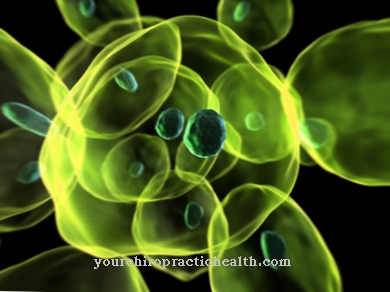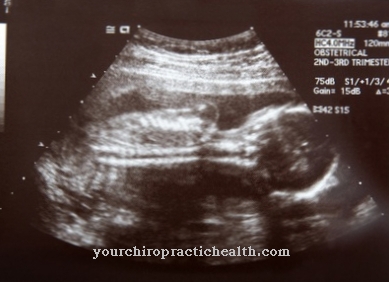Competitive inhibition is the inhibition of an enzyme or receptor by so-called antagonists or inhibitors. These are substances that have the same chemical structure as the body's own substance that is intended to bind to the target structure.
What is the competitive inhibition?

Various structures in the human anatomy are endowed with binding sites. Such structures include, for example, receptors and enzymes. As a rule, various substances are able to bind to the binding sites of these structures. If several substances compete for binding to an anatomical structure, then there may be a competitive inhibition of the target structure.
Biochemistry and pharmacology know the competing substances as agonists and antagonists. The agonist is a substance that occupies receptors and activates signal transduction by binding. Agonists are either endogenous substances or artificial imitations of such substances. In pharmacology, antagonists are substances that inhibit the action of an agonist.
When a structure is inhibited by the binding competition of agonist and antagonist, there is competitive inhibition. In competitive inhibition, an agonist and an antagonist fight to occupy the target structure. As a rule, the antagonist itself has no biochemical effect.
A distinction is to be made between non-competitive inhibition and non-competitive inhibition, in which the inhibitor does not attach to the active enzyme center, but rather binds to another site of the enzyme and in this way achieves a change in conformation and inactivation of the enzyme.
Function & task
Agonists occupy certain receptors in the body and together with them form complexes with a certain effect. Receptors are stimulus-receiving sites with a specific structure for binding to an agonist. The ability to bind receptors and trigger effects is called intrinsic activity. The antagonists to a particular agonist are similar in chemical structure to the agonist and thus occupy the receptors intended for it. However, an antagonist-receptor complex does not develop the effect that is intended for the agonist-receptor binding. The effect of the receptor is inhibited by the occupation with an antagonist.
The strength of the binding efforts between a certain substance and a receptor is called affinity. Antagonists must have a higher binding affinity than the agonist in order to be able to displace an agonist from its receptors. This principle follows the law of mass action. This means that with the same binding affinity, the agonist can still be displaced if the antagonist is present in a higher concentration. Non-competitive antagonists can be displaced by more highly concentrated agonists. This principle does not apply to competitive antagonists. The strength of competitive antagonists is the so-called pA2 value and is determined using the Schild plot.
Most of the antagonists in pharmacology are physiological, i.e. endogenous substances. In addition to enzymes, mediators and their antagonists are mainly used in drugs today. For example, histamine is an inflammation-mediating tissue hormone. It is a physiological agonist that binds to specific histamine receptors and causes redness, swelling and pain in the tissue through the binding. The physiologically intended effect of the agonist-receptor complex in this case is the inflammatory reaction.
Pharmacology relies on H1 antihistamines as antagonists to histamine. These substances are extremely similar to histamine biochemically and are thus able to displace the histamine from the receptor. As an antagonist-receptor complex, these antagonists have no effect of their own. H1 antihistamines can prevent or at least reduce inflammation.
In terms of enzymes, medicine speaks of an inhibitor when it comes to an inhibitor, which competes with the intended substrate for an active center. The enzyme cannot convert the inhibitor and therefore stops working. The inhibition only lasts if the concentration of the inhibitor remains high enough.
Illnesses & ailments
Inhibitors based on the principle of competitive inhibition are used to treat various clinical pictures. For example, competitive inhibition therapy is widely used in the treatment of acute gout attacks. The NSAID inhibitor is used to inhibit prostaglandin synthesis. It inhibits cyclooxygenase, an enzyme involved in inflammatory metabolism. This inhibition produces a pain-relieving and anti-inflammatory effect. Conventional remedies for acute gout are ibuprofen or diclofenac.
The main inhibitors used in chronic gout are [[uricostatics]. These substances inhibit xanthine oxidase. Xanthine oxidase oxidizes hypoxanthine to xanthine, which eventually becomes uric acid. By inhibiting xanthine oxidase, uric acid production decreases and gout symptoms are reduced. At the same time, the administration of the inhibitor increases the hypoxanthine concentration in the body. Purine synthesis is also inhibited from now on.
Competitive inhibition offers a decisive advantage over other inhibition methods. The pharmacologist differentiates between reversible and irreversible inhibition. In the case of irreversible inhibition, there is an irreversible inhibition process. The process cannot be reversed even with a more highly concentrated agonist. In the case of reversible inhibition, however, there is reversibility. Competitive inhibition can therefore in most cases be canceled again by increasing the agonist concentration. This type of inhibition is therefore one of the most important modes of action for drugs.
However, the inhibition mechanism by inhibitors is not exclusively associated with therapies and therapeutic successes. For example, inhibition also plays a role in the development of cancer. Tumor cells release apoptosis inhibitors and thus increase their vitality. They give themselves a resistance to immunological therapies and prevent their own cell death.













.jpg)

.jpg)
.jpg)











.jpg)